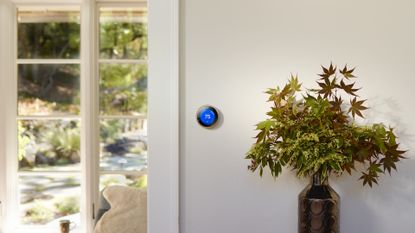What is a smart heating system? Explained - the way to save money and the environment, from home
A smart heating system could change the way you heat your home to save you money and help nature at the same time


A smart heating system is fast becoming more popular than ever as it moves from tech luxury to life necessity. The face of these systems is a smart thermostat, which you may have already seen in the form of the Google Nest Thermostat above, or other variants – as more companies jump on the smart home heating bandwagon.
Now, as energy prices climb and home heating becomes a topic of focus, these smart systems are more valuable and sought after than ever. And it's a good time to get involved as, after year of fine tuning, they're now working better than ever and, importantly, are better looking than ever before.
All that means you can turn your current thermostat into a home decor statement with a smart home thermostat – while at the same time reducing bills and even helping the environment. So are smart thermostats worth it?
And what exactly is a smart heating system, how can you get one and what will it cost?
What is a smart heating system?
At its core a smart heating system is actually very similar to your current setup. Meaning the way your home is heated will likely remain the same. The system will simply make the controls more intelligent. So if you have a combi boiler and radiators and, or underfloor heating and AC in your home, that will remain the same. But it will be your thermostat which will change.

A thermostat is a device that is able to measure the air temperature around it and turn your heating and, in some cases, cooling on and off to make sure that level stays at a set amount. So if you have this placed well in the center of your home, it'll adjust your heat and cooling to keep the most consistent temperature possible. So far, so standard thermostat.
Traditional thermostats let you set timers for heating and cooling to come on and off – with a lot of fiddly effort. Modern smart thermostats are not only easier but are actually enjoyable to use.
Just to be clear, the smart thermostat is not to be confused with a smart meter. A smart meter is simply a way to track your energy usage in the home. Moving on.
How does a smart heating system work?
Since the thermostat is at the heart of a smart heating system it's that which you need to know about. Unlike those that went before, these are usually good looking with touch or wheel controls and large color displays that light up so you can see if day or night. But the key here is that they're also WiFi connected to the internet.
That means you can control your smart thermostat, and your home heating and cooling, from a smartphone, tablet, computer – just about anything that'll get you to a browser or app that's online. That makes setting up a timer schedule super simple. But this does so much more.

What makes thermostats smart?
Imagine if you were going out everyday, to work, and your heating timer was set to turn on and off so the house cooled and heated to avoid wasting energy while you're out. That's great, until you factor in more people living there, less regularity to movements, drying clothes, and plenty more real life scenarios that make timers defunct.
A smart thermostat will be able to detect as people come and go, adjusting the heating or cooling as needed. And you can also do it from your phone manually, anywhere. Many will even work with your smartphone location so they can tell when you're nearing home to get the house to the right temperature for when you get to the front door. Home has never felt so homely.
These also work with smart voice controlled systems like Google Assistant, Apple's Siri, Amazon Alexa and more. All that means you can tell your Echo device, smartphone or even car on approaching home, to set the thermostat to an ideal temperature. Watching a movie and want to get cosy without moving? Just tell your smart device to turn up the heat.
How do smart thermostats control temperature?
One of the issues with thermostats, smart or otherwise, is that they can only detect the temperature in one part of the house. So while the thermostat in the hall may always be the same temperature, a room with the door closed could get really hot or cold. This is where smart radiator valves come in.

Many systems also offer these valves so you can actually set the temperature of individual rooms or zones. Want to have downstairs turn off overnight as you keep the bedrooms upstairs at the right temperature only? This can be done, keeping you comfy and saving you money at the same time.
It's also worth noting these can work in conjunction with other smart devices. Link up a set so when you tell you smart device it's bedtime, the lights go down and heating lowers ready for bed, for example.
So which is the best smart heating system for you? It depends on a number of factors including which brand you already use in your smarthome and want to integrate with. Also what the device looks like, how much it costs, if it controls hot and cold, and if you need room by room controls, all come into consideration.
Be The First To Know
The Livingetc newsletter is your shortcut to the now and the next in home design. Subscribe today to receive a stunning free 200-page book of the best homes from around the world.
Luke is a veteran journalist and editor of over two decades where he has written about everything but specialises is technology, science, health and fitness, smart homes and health. He contributes to Real Homes, T3, Tom's Guide and TechRadar, among many other titles. As a father of two, any spare time he gets is enjoyed surfing, reading, hiking, camping and generally getting out in nature.
-
 How to Thaw a Frozen Pipe — Learn Everything You Need to Know in 5 Minutes With This Guide
How to Thaw a Frozen Pipe — Learn Everything You Need to Know in 5 Minutes With This GuideWinter storm caught you off guard? We asked an expert — just how do you thaw a frozen pipe?
By Hugh Metcalf Published
-
 The 12 Very Best Silk Bedding Pieces — As Our Style Editor Says: 'It's What Dreams Are Made Of!'
The 12 Very Best Silk Bedding Pieces — As Our Style Editor Says: 'It's What Dreams Are Made Of!'Slumber in lustrous luxury with the very best silk bedding sheets, duvets, pillowcases, and more — your sleep score will thank us later
By Julia Demer Published
-
 6 Resolutions to Make Your Smart Home Better in 2024 — This is How to Get More From Your Tech
6 Resolutions to Make Your Smart Home Better in 2024 — This is How to Get More From Your TechMake your smart home work better for you in the new year with these tips to get things firing on all cylinders
By Alan Martin Published
-
 'Okay, That's Genius!' I've Just Discovered This 'Temperature-Controlled' Outlet That has so Many Clever Uses
'Okay, That's Genius!' I've Just Discovered This 'Temperature-Controlled' Outlet That has so Many Clever UsesWith a thermometer built in, these outlets can power devices when the temperature hits a certain point, making them ideal for many use cases
By Alan Martin Published
-
 In your smart TV spying on you? This is what data your TV collects and how can you make it more private
In your smart TV spying on you? This is what data your TV collects and how can you make it more privateInternet-connected smart TVs are designed to make your life easier, but that convenience comes with a price: personal data.
By Alan Martin Published
-
 What is human-centric lighting? Meet the smart controls we think every home will have in the future
What is human-centric lighting? Meet the smart controls we think every home will have in the futureHuman-centric lighting systems claim to help boost your wellbeing at home. Here's how they work
By Hugh Metcalf Last updated
-
 What is Netflix spatial audio? Explained: the new sound innovation to improve your next boxset binge
What is Netflix spatial audio? Explained: the new sound innovation to improve your next boxset bingeNetflix spatial audio makes TV and movies more immersive than ever, right in your home and here's how you can enjoy it.
By Luke Edwards Published
-
 Are smart thermostats worth it? How much money can they save?
Are smart thermostats worth it? How much money can they save?Tempted to invest in one of the latest smart heating systems? We ask 'are smart thermostats worth it?' and see if they can reduce your energy bills
By Emily Peck Published
-
 Netflix vs Hulu – which is best? The guide to picking the right streaming platform for you
Netflix vs Hulu – which is best? The guide to picking the right streaming platform for youNetflix and Hulu both have their strengths and weaknesses, but which should you put your dollars behind?
By Alan Martin Last updated
-
 QLED vs OLED – what's the difference? Experts explain how to choose the right TV for you
QLED vs OLED – what's the difference? Experts explain how to choose the right TV for youLooking for a new TV and not sure whether to choose OLED or QLED? Here's all you need to know about these top of the range TV technologies
By Emily Peck Last updated









